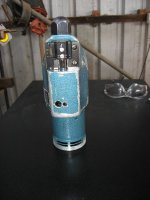RC99
Diamond
- Joined
- Mar 26, 2005
Biax 7EL assembly/repair (warning pic heavy)
I recently purchased a Biax 7EL scraper off ebay... The motor in it has problems which I knew about before I purchased and while I am getting them sorted out I decided to disassemble the mechanism and give it a clean and re-grease, while doing this I took note of the bearing numbers and also took photo's as I know a few members here have these machines and may need the info in the future....
Now the pictures are going to look a bit strange as I took them as I was putting it back together, but anyway here goes.
Firstly remove the motor assembly from the mechanical assembly by unscrewing the chromed ring.. It will end up looking like this

Then remove the hexagonal end cap and the tool holder (the tool holder screws are very tight, do not strip the heads, use the correct screwdriver), then remove the three small nuts, including the one that holds the leather strap on, the rear nut is shown in this picture.
You will end up with two pieces like so


Now remove the cotter pin on the stroke adjusting nut, remove the nut and screw out the adjusting bolt, then remove the three small screws on top of the stroke motion maker..Carefully prise out the top section so it looks like this

I recently purchased a Biax 7EL scraper off ebay... The motor in it has problems which I knew about before I purchased and while I am getting them sorted out I decided to disassemble the mechanism and give it a clean and re-grease, while doing this I took note of the bearing numbers and also took photo's as I know a few members here have these machines and may need the info in the future....
Now the pictures are going to look a bit strange as I took them as I was putting it back together, but anyway here goes.
Firstly remove the motor assembly from the mechanical assembly by unscrewing the chromed ring.. It will end up looking like this

Then remove the hexagonal end cap and the tool holder (the tool holder screws are very tight, do not strip the heads, use the correct screwdriver), then remove the three small nuts, including the one that holds the leather strap on, the rear nut is shown in this picture.
You will end up with two pieces like so


Now remove the cotter pin on the stroke adjusting nut, remove the nut and screw out the adjusting bolt, then remove the three small screws on top of the stroke motion maker..Carefully prise out the top section so it looks like this





















